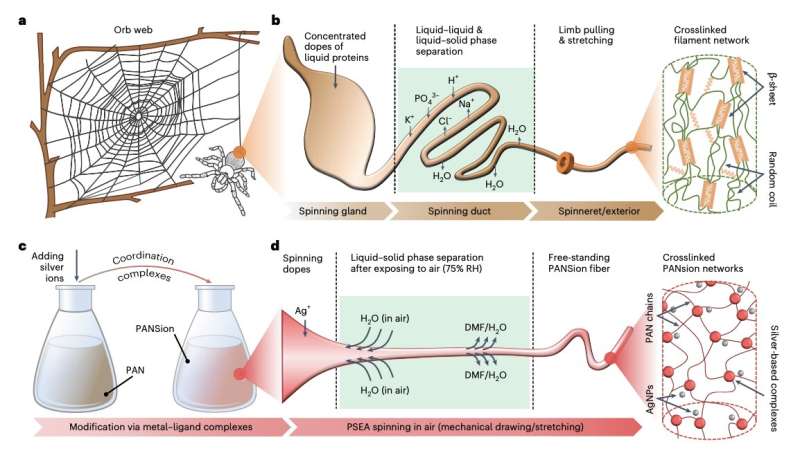A technique to spin soft functional fibers for smart textiles and wearable devices

In recent years, material scientists have been trying to develop soft and flexible fibers that could be used to create new electronics. These fibers could, for example, be used to create smart sensing clothes, energy solutions, and wearable biometric devices.
Researchers at National University of Singapore, University of California Los Angeles (UCLA) and Nanjing University in China recently introduced a new method to create soft textiles with electronic properties. This method, introduced in Nature Electronics, was inspired by the process through which spiders spin the silk threads used to create their webs.
“Soft fibers can be used to make smart textiles for use in energy, sensing and therapeutic applications,” Songlin Zhang, Yihao Zhou and their colleagues wrote in their paper. “However, the fabrication of functional fibers is difficult compared with the fabrication of two-dimensional films and three-dimensional monoliths, and current methods typically require high temperatures, high volumes of solvents or complex systems. We report a spinning approach to fabricate functional fibers, which is based on spontaneous phase separation and is inspired by the silk-spinning processes of spiders.”
Zhang, Zhou and their colleagues first produced a solution containing polyacrylonitrile (PAN) and silver ions dissolved in dimethylformamide (DMF). Thanks to the silver-based complexes in this solution, which the team refers to as PANSion, strengthens the dope used to spin fibers, allowing it to be spun at ambient temperatures and pressures.
This is a notable achievement, as many previously proposed methods to spin functional fibers require high pressures and thermal heating. The researchers’ proposed spinning process is thus far easier to implement on a larger scale, as it has fewer environmental requirements and consumes lower amounts of energy.
The silver ions in the solution are reduced to silver nanoparticles (AGNP), which also allows spun textiles to conduct electricity. The resulting fibers could thus prove very valuable for creating smart textiles, thin energy devices and even wearable sensors.
Ultimately, when the researchers’ solution is spun into fibers, it undergoes a spontaneous liquid-solid phase transition prompted by its exposure to air and humidity. The process through which this happens is known as a non-solvent vapor-induced phase separation (NVIPS).
“The silk-spinning process is mimicked by creating a spinning solution of polyacrylonitrile and silver ions, which forms an elastic supramolecular network with silver coordination complexes and in situ reduced silver nanoparticles,” Zhang, Zhou and their colleagues wrote in their paper. “This approach, which operates at ambient pressure and temperature, can be used to make soft functional fibers that are mechanically stretchable (more than 500% strain), strong (more than 6 MPa) and electrically conductive (around 1.82 S m−1).”
To demonstrate the feasibility of their spinning technique, Zhang, Zhou and their colleagues created fibers that they then used to create two different devices, namely a sensing glove and a smart face mask. To create the sensing glove, they used a commercially produced glove as a substrate, on which they sowed their PAN-Sion spun fiber. Changes in resistance picked up by this smart glove were picked up when it was bent or approached cold and warm surfaces, which were then converted into signals that could be transmitted to digital devices.
The sensing mask created by the researchers, on the other hand, was created by sewing the PANSion spun fiber onto a filter layer. When a user wearing this mask breathed in and out, this generated changes in resistance that could also be translated into signals, enabling the monitoring of the wearer’s breathing.
In the future, the fibers created by Zhang, Zhou and their colleagues could be used to create a wide range of other devices and wearable technologies. In addition, their proposed spinning technique and the solution it is based on could inspire the development of similar approaches to create functional fibers with electronic properties.
More information:
Songlin Zhang et al, Biomimetic spinning of soft functional fibres via spontaneous phase separation, Nature Electronics (2023). DOI: 10.1038/s41928-023-00960-w
© 2023 Science X Network
Citation:
A technique to spin soft functional fibers for smart textiles and wearable devices (2023, May 18)
retrieved 18 May 2023
from https://techxplore.com/news/2023-05-technique-soft-functional-fibers-smart.html
This document is subject to copyright. Apart from any fair dealing for the purpose of private study or research, no
part may be reproduced without the written permission. The content is provided for information purposes only.
For all the latest Technology News Click Here
For the latest news and updates, follow us on Google News.

